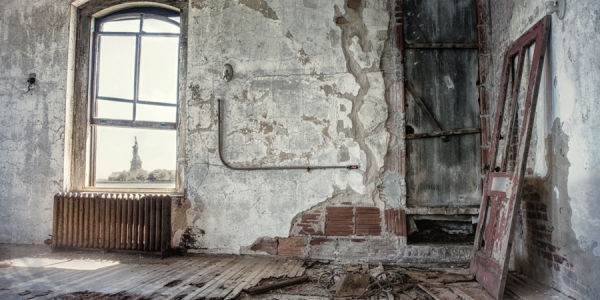
On Ellis Island, an Effort to Bring Its Long-Hidden Side Into Public Light
ELLIS ISLAND, N.J. — On a chilly afternoon, wind and rain whip through the broken windows of a small, dark room where people with tuberculosis once stared out at the Statue of Liberty and wondered if they would ever begin a new life in America.
The room stands off a long hallway in one of 30 brick buildings that once bustled with anxious immigrants and the doctors who screened them. Day and night, the noisy corridors were packed with new arrivals, waiting for a clean bill of health.
Today, the immigrants are gone and the same hallways are rotting, with collapsed roofs and broken glass on the floor. This is the Ellis Island that few ever see.
Although the main hall on the island's north side was turned into a museum in 1990, the buildings on the south side were left to deteriorate when the immigration center closed a little more than 50 years ago.
But now, thanks to a new national fundraising effort, the gateway's long-hidden side may be refurbished and opened to visitors.
Last month, the Save Ellis Island Foundation, a nonprofit group, announced a national campaign to raise more than $300 million to renovate the island's south side.
Bill Bradley, a former U.S. senator from New Jersey and a Princeton University basketball great, was named to head the fundraising drive.
The site includes a French Renaissance-style hospital, laundry and kitchen rooms, psychiatric detention cells, a baggage and dormitory building, a theater, a morgue and autopsy room. Sponsors hope to build a conference center to examine immigration issues.
Ellis Island was the main point of entry for 12 million America-bound immigrants from 1892 to 1954. Most of the 27-acre site -- a place where people were fed, sheltered and hospitalized -- has long been off-limits.
"The idea is to bring this long-forgotten place back to life, because right now when people visit Ellis Island, they only get a partial story," said Clem Price, a Rutgers University historian who has been working with the Save Ellis Island Foundation.
"People were born and people died at Ellis Island," he said. "Many were too sick to go right to the United States, so they were detained in hospitals. Others were judged mentally unstable or politically unsuitable, so they were put in special quarters. All of this is part of the story, and the south side of the island tells it."
New Jersey officials got involved in the renovation effort after the U.S. Supreme Court ruled in 1998 that New York and the Garden State both enjoyed a historical claim to Ellis Island.
Although the federal government owns and operates the facility, the court ruled that five acres of the island, including the main building, were in New York, and 22.5 acres, including the abandoned south side, were in New Jersey.
"Ellis Island, New Jersey -- I like the sound of that," then-New Jersey Gov. Christine Todd Whitman said soon after the ruling. "This is our history too."
Save Ellis Island sponsors hope the fundraising effort will echo the successful drive in the early 1980s headed by then-Chrysler Chairman Lee Iacocca to refurbish the Statute of Liberty and Ellis Island's main hall.
The campaign still needs approval from the National Park Service before it officially gets underway.
"It's astonishing to think of the history that's packed into this place," said Liz Thomas, a publicist working with the foundation, on a recent tour of the island's south side. "But it's also troubling that so much of this place is run-down. It's a part of our national history, something you think would have been better cared for."
Ellis Island was called "Island of Hope, Island of Tears" as it welcomed a flood of immigrants from German, Irish, Italian, Jewish, Polish, English, Scandinavian and African cultures, among others. But it is easy to understand the bittersweet title, given the grim layout of buildings in the southern section.
Medical examiners, for example, steered new arrivals to isolation wards if they showed any signs of diseases such as tuberculosis, measles, chicken pox, diphtheria or ringworm. In extreme cases, sick people were deported, as were those who had been determined to be politically unsuitable.
All immigrants were screened for possible mental illness. Those who showed signs of impairment were put in special isolation quarters and given basic intelligence tests. If they failed to pass, they could be deported.
The island also had facilities for mothers about to give birth, and a mortuary for the immigrants who died on Ellis Island. Many could not survive the turbulent, dangerous passage in the cramped steerage sections of the ships they sailed on, historians say.
There was even a room where autopsies were done, with special concrete seats for doctors to watch the procedures. Elsewhere, large laundries washed clothing and sheets for immigrants who had to spend more time on the island.
